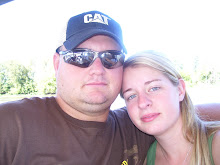
Yesterday I was lucky enough to head out to the beach with a friend for the first part of the day. My fiance, Brian, was working for our friends that grow pickles so when I got home I decided to go ride in the semi with him. He was driving a semi with doubles behind it. That means it has 2 separate trailers behind it. The whole rig from front bumper to rear hitch is 70' long. The set of 2 trailers is also known as "trains". They aren't too hard to drive but they are very tricky to back up. Brian drove the same setup for 4 years at an excavating company so he does great with them. I'm so proud of him! :) Anyway, enough bragging, on to the story of pickles...
Pickle farmers try to schedule their planting so that they know exactly what day the pickles will be ready to harvest. If it is 90 degrees and humid out the pickles can grow very fast. They can be too small to pick in the morning and too big to pick at night. Our friends had a 30 acre field ready to be picked on Saturday and the 30 acres next to it was supposed to be ready for Sunday. The pickles had other ideas though and as it turns out the whole 60 acres were ready to be picked on Saturday.
This made for a lot of rushing around before a big rainstorm hit. These farmers have an 8-row harvester and a 4-row harvester. The 8-row does most of the work while the 4-row gets the headlands and the extra little corners and things. The pickles are loaded in to semis and hauled to the factory. On Saturday they were hauling to factory about 45 minutes away. They had 6 semis (5 singles + the trains) going nonstop to keep up with the harvester. It takes 20 minutes to unload a single trailer and sometimes the line at the factory can be a 2-3 hour wait. Each of the single trailers made 2 trips to the factory that day and the trains went once.
Whenever I ride in a semi I always get a little nervous about the traffic. I would love to learn to drive one but it can be so stressful, especially with all the people on the road who don't appreciate trucks or know anything about them. We had the classic idiot who pulled out in front of us, making Brian downshift, then decided to slow down and turn just as we were getting up to speed again. Then, as we were navigating through the stoplights in town we met the driver who doesn't know what the white line at the stoplight is for. Boy did she back up real fast when we made a right turn and almost kissed the front bumper on her Grand Prix!
Sorry for complaining but I get really sick of ignorant people. I hope that by sharing experiences like this maybe more people can learn about things like this. If you don't know much about semis I would suggest taking it upon yourself to learn the basics. For example, don't ever pull up close behind a semi at a stop sign or light. Even on the slightest hill the truck will roll backward as the driver let's out the clutch to accelerate. It is big pain when they have to worry about rolling back in to you!
Okay, back to the pickles. So when we get to the factory the first thing to do is get weighed. We pulled on to a very large scale and the weight shows up on a little display so we can see it. The train weigh 160,000 lbs. when fully loaded. This is the gross, or total, weight and included the truck plus the pickles. The single trailer weighed in at 120,000 lbs. loaded. A women in the little trailer beside the scale logs your weight and gives you a paper for each load. After you unload you weigh the truck again to get the weight of the pickles. The single trailer weighed about 50,000 lbs. empty so that means we brought in 70,000 lbs of pickles in one load.
After weighing in, and maybe waiting in line, the driver backs to truck up to the "pit". The pit is just what it sounds like, kind of a hole with metal sides. The dump box is raised up just enough for a big pile of pickles to come out. There is a big conveyor belt that takes the pickles away from the bottom of the pile. Eventually the driver can raise the box more and more until all the pickles come out. Like I said earlier, unloading takes about 20 minutes.
The conveyor takes the pickles in to the factory to be cleaned and sorted. It drops them from one belt to another so a lot of the leaves and debris fall off the belt. Then they are run through a tank where water is sprayed on them at high pressure to get a lot of the dirt off. The next tank has red hose-like belts that pull through the water. The pickles go between all these belts and get scrubbed clean. The conveyor takes them through several tanks like this and then rinses them with clean water.
Afterward the conveyor goes by workers that manually sort the pickles. Any that are not the right side or that are damaged go back on a separate conveyor and are spit out in to a bin near where the truck sits. The pickles that pass inspection leave the factory on another conveyor and are loaded in to clean trucks that belong to the factory. They go to another part of the factory grounds and are stored in big tanks of brine until they are needed for further processing.
When the last pickle slides out of the truck the driver puts the trailer down. The debris and damaged pickles are dumped back in to the truck to take back home. The scraps are usually dumped in a vacant field to compost. Since pickles are mostly water it doesn't take long at all for them to breakdown. A pile 10' tall could be almost gone after a day or two.
I hope some of you found this interested and learned a little something. I did get to walk around and see some of the factory for myself while the truck was being unloaded. I know a lot of people aren't as close to commercial food production as I am so I like to share these experiences. This post is titled Part 1 because I hope to add more about pickle farming later. Next weekend maybe I'll get to ride in the harvester and tell you how that works!











1 comment:
This was facinating! It's hard to imagine timing it all so perfectly, but I've seen cucs in my garden grow phenominally in one day, so it makes sense. Thanks for writing about it. The more we know about the work involoved in farming, the better, in my opinion.
Post a Comment